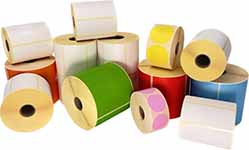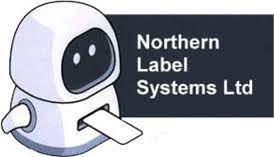We use cookies to make your experience better. To comply with the new e-Privacy directive, we need to ask for your consent to set the cookies. Learn more.
Rolls of Labels - What you need to know to get the right labels for your label printer

Rolls of Labels by Material Type
Choosing your label material type is a very important first step. You can see all the types of labels we supply here.
If your label printer does not use an ink ribbon then you will need Direct Thermal (heat sensitive) labels. In most instances, Direct Thermal labels are used for the short-term labelling of products. They are a very popular choice for shipping labels, best before date labels, pricing labels, ingredient labels, etc.
The benefit of using direct thermal labels is the fact that you do not need any type of ink to print them. The thermal printhead on the label printer reacts to the label's thermal coating and produces the text, barcode, etc. required. The label printer that is needed to print these labels is generally cheaper than one that uses ink ribbon so start-up costs are also reduced.
The downside to Direct Thermal labels is that they fade in sunlight (UV light) and are not suited to water or chemical contact. They also turn black if rubbed against something or if they are scratched. Economy thermal labels are also not resistant to plasticisers, so if, for example, you put clear adhesive tape over the label (as some people do for extra security or adhesion), then the plasticisers react with the chemical coating and can actually make what is printed on the label disappear!
Direct Thermal labels are also available as a 'Top Coated' product. This 'top coating' gives some resistance to water and makes the labels much less susceptible to UV light and to the affects of plasticisers. Top coated labels are generally more expensive than standard economy Direct Thermal labels and are used when the end user does not have access to a Thermal Transfer label printer.
Thermal Transfer paper labels are labels that use an ink ribbon to print them. The print head of the label printer heats up and 'burns' the ink onto the surface of the label.
The benefits of using paper Thermal Transfer labels are that they have some water and chemical resistance, and the print is more durable when rubbed. Paper Thermal Transfer material is also not susceptible to UV light or plasticisers.
Synthetic Labels are also available on rolls to be printed on label printers that use an ink ribbon. Types of synthetic labels include polypropylene, polyethylene, and polyester.
The most common and cost-effective choice for synthetic label material is polypropylene. Polypropylene labels offer water as well as oil and chemical resistance and good tear resistance.
Polyethylene labels are also resistant to water, oil, and chemicals and are best suited to applications where flexability is required, e.g. for curved surfaces and 'squeezable' packaging.
Polyester labels have an extremely long life span and have excellent resistance to heat as well as water, oil and chemicals. Applications include car engine parts, household appliance labelling, electrical item serial number labelling, and labels that have to withstand high temperatures like that used in an UltraClave sterilising process.
Rolls of labels by Adhesive type
Adhesive types include Permanent, High Tack, Removable, Freezer and Blockout.
Permanent adhesive labels are the most common type and will stick to almost all surfaces. Permanent adhesive is ideal for sticking to cardboard, paper, painted surfaces, plastic, wood, glass etc.
High Tack adhesive labels are suitable for applications where the surface that the label is being applied to is not smooth or has a rough texture.
Removable adhesive labels are best suited to applications where the label needs to be easily removed after it has been applied. Applications include price labelling, labelling a surface that is easily damaged e.g. a painted surface or where the label will not be permanently stuck to the object.
Freezer adhesive labels are used for labelling frozen products that will be stored in a freezer or deep freeze. The strong freezer adhesive is suitable for applications where temperatures can go as low as -40°C. The temperature of the item being labelled should be -20°C or above at the point of labelling. After the label has been applied to the product and the adhesive has set, the temperature can then go down to -40°C.
Blockout adhesive labels are used for re-labelling items. The adhesive is a dark blue colour and has been designed so that you cannot see what is printed on the surface the label has been stuck to. These are ideal for covering up an old incorrect price, text or barcode, etc with a new one.




